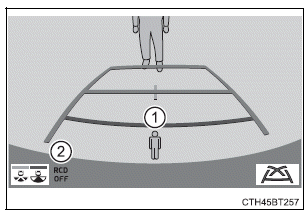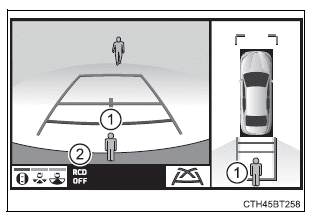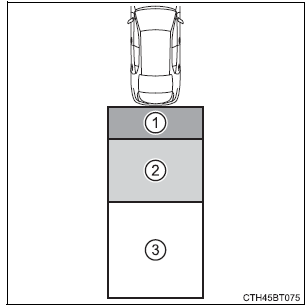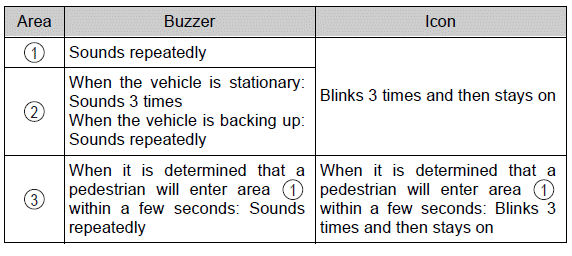Toyota Camry (XV70): RCD (Rear Camera Detection)
When the vehicle is backing up, the rear camera detection function can detect pedestrians in the detection area behind the vehicle. If a pedestrian is detected, a buzzer will sound and an icon on the audio system screen will be displayed to inform the driver of the pedestrian.
Display
Toyota parking assist monitor

Panoramic view monitor

- Pedestrian detection icon
Displayed automatically when a pedestrian is detected. - RCD OFF icon
When the RCD function is disabled, the RCD OFF icon illuminates.
Turning the rear camera detection function on/off
Vehicles with 4.2-inch multi-information display
1. Press  of the meter control
switches, select
of the meter control
switches, select  .
.
2. Press  of the meter control
switches, select
of the meter control
switches, select  .
.
3. Press  of the meter control
switch.
of the meter control
switch.
When the RCD function is disabled, the RCD OFF indicator illuminates.
Vehicles with 7-inch multi-information display
1. Press  of the meter control
switches, select
of the meter control
switches, select  .
.
2. Press  of the meter control
switches, select
of the meter control
switches, select  .
.
3. Press  of the meter control
switch.
of the meter control
switch.
When the RCD function is disabled, the RCD OFF indicator illuminates.
When a pedestrian is detected
If the rear camera detection function detects a pedestrian in the detection area, the buzzer and icon will operate as shown in the following table:


■The rear camera detection function is operational when
The rear camera detection function is operational when the following conditions are met:
- The engine switch is in the "ON" position (vehicles without a smart key system) or in IGNITION ON mode (vehicles with a smart key system).
- RCD function is on.
- The shift lever is in R.
■Setting the buzzer volume
The buzzer volume can be adjusted with the RCTA buzzer volume on the multi-information display.
■Muting the buzzer sound
The buzzer can be temporarily muted by pressing of the meter control switches while an object detection display is shown on the multi-information display.
■If "Rear Camera Detection Unavailable Remove the Dirt of Rear Camera" is displayed on the multi-information display
A rear camera lens may be dirty or covered with snow or ice. In such cases, if it is removed from the rear camera lens, the system should return to normal.
(It may be necessary to drive the vehicle for some time before the system returns to normal.)
■If "Rear Camera Detection Unavailable" is displayed on the multi-information display
- If this message is displayed after the battery has been disconnected and reconnected, fully turn the steering wheel to the left and then the right on level ground.
- If this message is displayed only when the R shift position is selected, the rear camera lens may be dirty. Clean the rear camera lens.
■Situations in which the system may not operate properly
- Some pedestrians, such as the following, may not be detected by the rear
camera detection function, preventing the function from operating properly:
- Pedestrians who are squatting
- Pedestrians who are lying down
- Pedestrians who are running
- Pedestrians who suddenly enter the detection area
- Pedestrians riding a bicycle, skateboard, or other light vehicle
- Pedestrians wearing unusual clothing, such as a costume
- Pedestrians whose body is partially hidden by a cart or other object
- Pedestrians which are obscured by darkness, such as at night
- In some situations, such as the following, pedestrians may not be
detected
by the rear camera detection function, preventing the function from
operating
properly:
- When backing up in inclement weather (rain, snow, fog, etc.)
- When the rear camera is obscured (dirt, snow, ice, etc. are attached) or scratched
- When a very bright light, such as the sun, or the headlights of another vehicle, shines directly into the rear camera
- When backing up in a place where the surrounding brightness changes suddenly, such as at the entrance or exit of a garage or underground parking lot
- When backing up in a dim environment such as during dusk or in an underground parking lot
- When the camera position and direction are deviated
- When a towing hook is attached
- When water droplets are flowing on the camera lens
- When the vehicle height is extremely changed (nose up, nose down)
- When tire chains is used
■Situations in which the system may operate unexpectedly
- Even though there are no pedestrians in the detection area, some
objects,
such as the following, may be detected, possibly causing the rear camera
detection function to operate.
- Three dimensional objects, such as a pole, traffic cone, fence, or parked vehicle
- Moving objects, such as a car or motorcycle
- Objects moving toward your vehicle when backing up, such as flags or puddles (or airborne matter, such as smoke, steam, rain, or snow)
- Cobblestone or gravel roads, tram rails, road repairs, white lines, pedestrian crossings or fallen leaves on the road
- Metal covers (gratings), such as those used for drainage ditches
- Objects reflected in a puddle or on a wet road surface
- Shadows on the road
- In some situations, such as the following, the rear camera detection
function
may operate even though there are no pedestrians in the detection area.
- When backing up toward the roadside or a bump on the road
- When backing up toward an incline/decline
- If the rear of the vehicle is raised or lowered due to the carried load
- If a bumper protector, such as an additional trim strip, is installed to the rear bumper
- If the orientation of the rear camera has been changed
- If a towing eyelet is installed to the rear of the vehicle
- When the rear camera is obscured (dirt, snow, ice, etc. are attached) or scratched
- When water is flowing over the rear camera lens
- If there is a flashing light in the detection area, such as the emergency flashers of another vehicle
- When a tire chains is used
- Situations in which the rear camera detection function may be difficult
to
notice
- If buzzer may be difficult to hear if the surrounding area is noisy, the volume of the audio system volume is high, the air conditioning system is being used, etc.
- If the temperature in the cabin is extremely high or low, the audio system screen may not operate correctly.
WARNING
■Cautions regarding the use of the system
The recognition and control capabilities for this system are limited.
The driver should always drive safely by always being responsible without over relying on the system and have a understanding of the surrounding situations.
■To ensure the system can operate properly
Observe the following, otherwise there is the danger that could lead to an accident.
- Always clean the camera without damaging it.
- Do not install market electronic parts (such as Illuminated license plate, fog lamps, etc.) in the camera vicinity.
- Do not subject the camera vicinity to strong impacts. If the vicinity is subjected to a strong impact, have the vehicle inspected at your Toyota dealer.
- Do not disassemble, remodel or paint the camera.
- Do not attach accessories or stickers to the camera.
- Do not install market protection parts (bumper trim, etc.) to the rear bumper.
- Maintain suitable tire air pressure.
- Make sure the trunk is completely closed.
■RCD function is turned off
In the following situations the system turns off. The RCD function may not operate properly and thus there is the danger that an accident may occur.
- The contents mentioned above are not observed.
- Suspensions other than Toyota genuine parts are installed.

